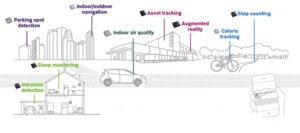A new universal connectivity standard will help bring Single-Pair Ethernet to the Industrial Internet of Things. Eric Leijtens, TE Connectivity The rise of the Industrial Internet of Things (IIoT) places new demands on industrial networks. With the increasing number of IIoT nodes, there’s a need for a simplified, economical communication infrastructure at the field level. […]
teconnectivity
RF/optical hybrid modules work with VPX-based embedded computing systems
TE Connectivity is introducing its NanoRF optical hybrid modules for the defense industries VPX-based embedded computing systems that require increased bandwidth and radio frequency (RF) signaling. The new hybrid modules feature high-density RF and optical connections within common connector module applications like radar, electronic warfare (EW) missile guidance, and tactical communications, along with any other small […]
Antennas for smart IoT applications
IoT antennas increasingly must handle frequencies well beyond the ISM band and into the cellular and 5G spectrum. Christian Koehler, Felisa Chuang • TE Connectivity The Internet of Things (IoT) bridges the gap between the physical and virtual worlds. Machine to machine (M2M) communications–via low-powered networks such as UWB, WLAN, Zigbee or Bluetooth–has helped drive […]
Optimizing in-vehicle data networks
Physical channels have limits that affect the practicalities of automotive network architecture and communication protocols. Here’s the lowdown on current work aimed at breaking bandwidth bottlenecks. CHRISTIAN RUSCH, BERT BERGNER | TE Connectivity It has become a truism that we have an insatiable appetite for data. Not so obvious is the effect our need for […]
Single-Pair Ethernet system targets commercial aircraft uses
TE Connectivity has announced its new Mini-ETH Single Pair Ethernet system for commercial aircraft that offers substantial weight savings, more bandwidth and simpler installation and maintenance by using proven technologies from other markets. As designers search for greater efficiency onboard aircraft, TE’s new Mini-ETH system offers them up to 73% weight savings in cables and up […]
Ultra-compact digital temperature sensor features precise digital output, low power consumption
In today’s world, industrial, consumer and even medical sectors are adopting digitalization to collect sensor data. While certain devices are fitted with analog-to-digital converters, the market demands increased accuracy, smaller size, higher versatility and lower prices as data is used for more precise controls. To meet this emerging need, TE Connectivity (TE), a world leader […]
Sensor IC checks humidity, temperature in two locations using single I2C bus line
From refrigerators and respirators to HVAC systems and cabin comfort in vehicles, there is an increasing demand for humidity sensing technology and the need for smaller, faster, more accurate and energy-efficient sensors, which provide better analysis of moisture control. To address this trend, TE Connectivity (TE) has released the HTU31 humidity and temperature sensor, one of […]
Digital pressure/temperature sensor targets embedded apps
Miniaturization, performance, and precision are key for sensors embedded in consumer devices like swim watches and diving equipment, therefore creating a growing need for high-performing and exceptionally precise sensors. To address this growing demand, TE Connectivity (TE) has released the MS5839-02BA, an ultra-compact, chlorine resistant digital pressure, and temperature sensor. The MS5839 is a digital […]
How the IIoT makes factories smart
Factories have always set their sights on increased productivity and cost reduction and the Industrial Internet-of-Things (IIoT) has impacted modern factories in a big way. To achieve those goals, modern factories have made automation and preventive maintenance using robotics, artificial intelligence (AI), and edge computing top priorities. In the next 10 years, factories with IIoT […]
The role of sensors in IoT networks, Part 2: Smart sensors and how to choose
Part 2 of this series continues with answering common questions about how sensors work in IoT system development. What are smart sensors? Basic sensors can detect changes in their environments and convert measured data into a digital format for the external microcontroller to process. The “smart” is in the microcontroller. Combining the microcontrollers in a […]









